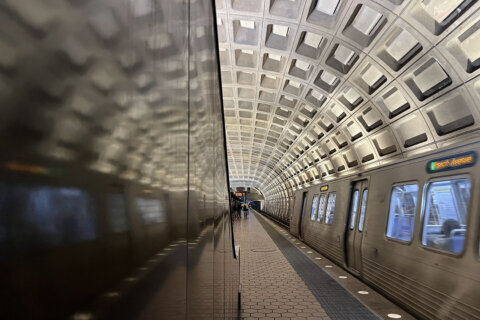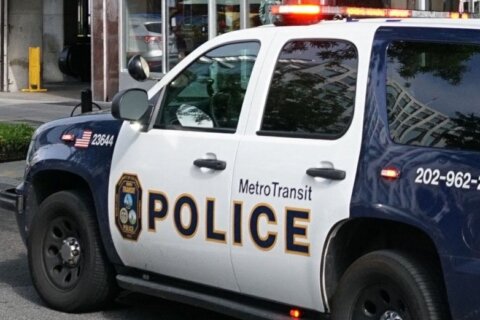This article was written by WTOP’s news partner InsideNoVa.com and republished with permission. Sign up for InsideNoVa.com’s free email subscription today.
Extending a Metrorail line to Triangle in Prince William County would cost as much as $27 billion, the Virginia Department of Rail and Public Transportation estimates as it nears completion of a study of transit options along the U.S. 1 corridor.
The study will not recommend any particular option, but an executive summary released Tuesday says all five options studied are “feasible.” But more detail on the alternatives and analysis needs to be undertaken before a “locally preferred alternative” is selected.
The feasibility study, funded by the General Assembly last year, is the first step of what would be many if local, state and regional leaders decide to pursue one of the alternatives, intended to increase transit access and ridership while decreasing automobile congestion from Springfield to Quantico in Fairfax and Prince William counties.
Over the last year, DRPT staff and consultants have explored certain options:
Blue or Yellow Metro Line extensions to Triangle
An extension of Fairfax County’s already-planned U.S. 1 Bus Rapid Transit (BRT) line from Fort Belvoir to Triangle.
Slightly enhanced Virginia Railway Express service on top of planned service increases along the Fredericksburg line.
Bus enhancements that would add five new express routes.
The executive summary estimates that each proposed Metrorail extension would cost between $18 and $27.5 billion up front, the extended BRT would cost $2.4 billion to $3.6 billion, VRE improvements $116 million to $174 million and enhanced bus service $37 million to $54 million.
Those estimates don’t include annual operating and maintenance costs. Metro officials have long said that before the system can accommodate extensions into Prince William, it would need extensive and costly work to ease bottlenecks at the core of the system and increase capacity.
“The Express Bus and BRT alternatives are significantly more cost effective than the rail alternatives,” the summary reads. “Despite lower ridership, the Express Bus alternative has low costs, making it the most cost-effective alternative tested. The BRT alternative has higher costs than the Express Bus, but does increase ridership, making it 2-3 times more cost-effective than the Metrorail alternatives, which have high ridership, but significantly higher costs.”
Ridership increases
As far as increasing ridership is concerned, both Metrorail extensions and the BRT extension scored highest on adding transit trips to and from the study corridor.
In the scenarios explored, the Blue and Yellow line extensions would run 26.3 and 26.6 miles in length, respectively, and would each have 10 stations, including North Woodbridge, The Landing at Prince William, Potomac Mills, Potomac Town Center, Southbridge and Triangle. Trains would run every eight minutes during peak time periods and every 12 minutes off-peak.
The BRT extension would be 20.5 miles in length and add 18 stations, 14 of which would be in Prince William. Buses would run every six minutes during peak hours. Typically, the most successful BRT lines feature platform stations and dedicated right-of-way, separating the buses from other traffic, although the study does not include detailed right-of-way analysis.
The VRE enhancements studied would be minimal compared to what’s already in the works as part of the state’s Transforming Rail in Virginia plan, and so its projected ridership impacts scored lower, as do those for the express bus option. The VRE alternative also scored lowest on cost-effectiveness.
The study uses forecasts from the Metropolitan Washington Council of Governments projecting that population within the corridor will grow from its current 437,300 to 544,800 in 2045, a 24.6% increase. The council projects that employment within the corridor will grow by 34.3%.
At baseline, without any of the improvements explored in the study, DRPT expects transit ridership to grow simultaneously with population and employment growth. But it said the alternatives laid out in the study would significantly increase transit usage and regional accessibility.
“Transit trips from the study corridor are expected to grow by 55 percent, while transit trips to the study corridor are expected to grow by 85 percent,” the summary reads. “Transit trips to and from the corridor are expected to grow more than the population and employment levels, meaning that a higher proportion of people will be using transit than today, due to increased densities, severe traffic congestion, and planned transit improvements such as the Richmond Highway BRT and VRE improvements included in the future baseline scenario.”
Mitigating congestion
The options vary in how well they’re projected to mitigate traffic congestion, with the Metrorail extensions scoring highest in that regard and the VRE and express bus enhancements scoring lowest.
But the study also says that land-use changes around potential Metro or BRT stations would be crucial to maximizing return-on-investment and ridership for those three alternatives. Increased density, walkability and bicycle access around stations would allow the corridor to “grow more sustainably and reduce the future vehicular transportation impacts on existing roadways,” the study says.
The study noted that both Fairfax and Prince William are expected to have significant population and job growth in the next 25 years. “[Transit-oriented] planning within the Study Corridor that enhances transit ridership will be critical to leverage investments in premium transit.”
Public comment on the executive summary will be taken for 30 days, after which DRPT and its consultants will complete the study’s final report and submit it to the General Assembly. But no recommendations will be issued in that final report.
The study was pushed by a group of state lawmakers representing Prince William County who have advocated for bringing Metro south of the Occoquan River, including Sen. Scott Surovell (D-36th), Del. Luke Torian (D-52nd) and Del. Elizabeth Guzman (D-31st).
“The importance of the corridor as a growing, diverse community that includes regionally significant job centers supports further investigation of transit enhancement options,” the summary concludes.
Jared Foretek covers the Manassas area and regional news across Northern Virginia. Reach him at jforetek@insidenova.com.






